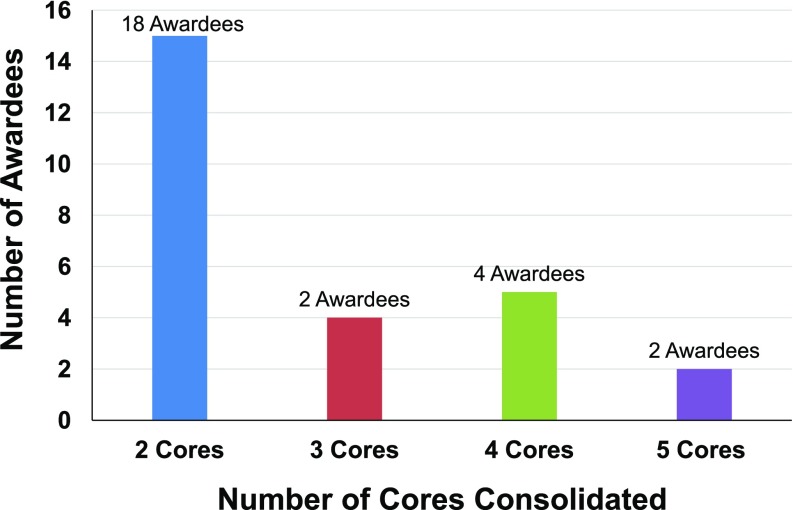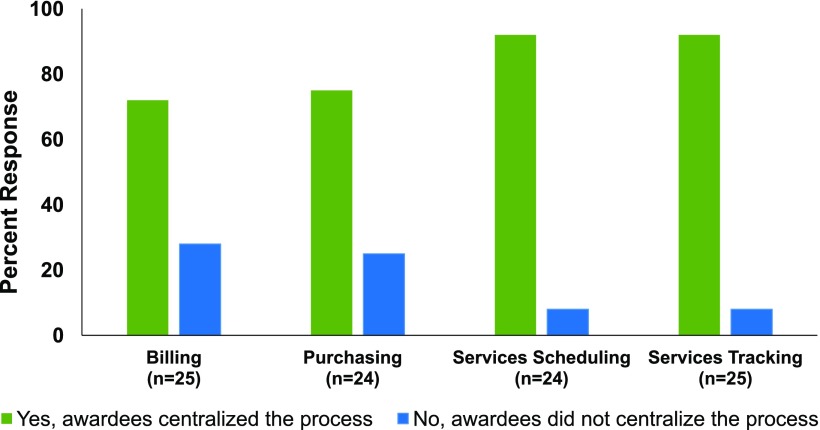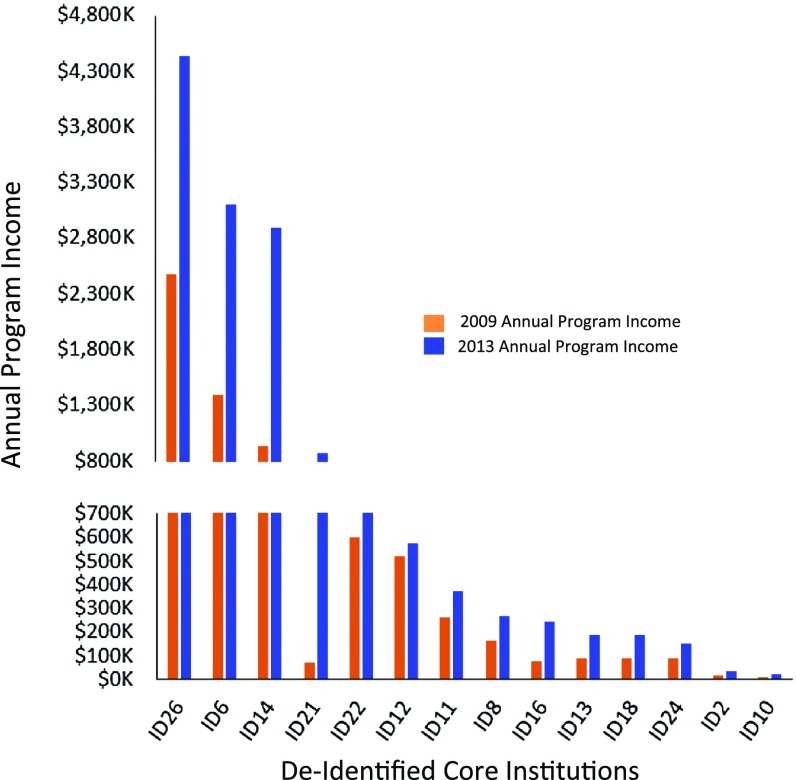Abstract
The U.S. National Institutes of Health (NIH) invests substantial resources in core research facilities (cores) that support research by providing advanced technologies and scientific and technical expertise as a shared resource. In 2010, the NIH issued an initiative to consolidate multiple core facilities into a single, more efficient core. Twenty-six institutions were awarded supplements to consolidate a number of similar core facilities. Although this approach may not work for all core settings, this effort resulted in consolidated cores that were more efficient and of greater benefit to investigators. The improvements in core operations resulted in both increased services and more core users through installation of advanced instrumentation, access to higher levels of management expertise; integration of information management and data systems; and consolidation of billing; purchasing, scheduling, and tracking services. Cost recovery to support core operations also benefitted from the consolidation effort, in some cases severalfold. In conclusion, this program of core consolidation resulted in improvements in the effective operation of core facilities, benefiting both investigators and their supporting institutions.
Keywords: centralized resources, infrastructure, shared technologies
Cores provide investigators with access to sophisticated technologies and specialized instrumentation operated by expert staff and consultation services on how best to use the resources to address wide-ranging research questions and how to analyze and interpret the information resulting from such advanced technologies. Cores are diverse, ranging from cores that focus on analytical instrumentation to cores providing for experimental design and evaluation needs, such as biostatistics, patient outreach, and clinical regulatory issues. The NIH has substantially invested in core facilities through a wide variety of programs. Core facility support using the P30, U54, P50, G12, and P01 (grants.nih.gov/grants/funding/funding_program.htm) grant activity codes was conservatively estimated at $900 million per year in 2010.1 Many institutions have multiple core facilities that appear to provide similar or identical services to groups of their investigators. The level to which institutions centrally manage and plan their cores varies widely. Anecdotally, centralized oversight can enhance efficiency and provide opportunities to reduce duplication and to consolidate cores when appropriate.
In an effort to understand the advantages of core consolidation, the NIH gathered information about core facilities through an initial Request for Information (NOT-RR-09-003) (grants.nih.gov/grants/guide/notice-files/NOT-RR-09-003.html) and two subsequent conferences (http://dpcpsi.nih.gov/sites/default/files/orip/document/final_workshop_report%20Cores%20july09%20%281%29.pdf). Based on this information, the NIH created a one-time program to encourage core consolidation activities using funds from the American Recovery and Reinvestment Act (ARRA) of 2009. This program was implemented by the NIH Administrative Supplements to Support Core Consolidation (NOT-RR-10-001) (grants.nih.gov/grants/guide/notice-files/NOT-RR-10-001.html) for the purpose of consolidating multiple cores into a single, more efficient combined core facility. The aim of the consolidation was to reduce the number of similar core facilities at an institution, thereby enabling pooling of resources, to become better organized in a more cost- and time-efficient structure. A single consolidated core was presumed to offer efficiencies such as access to more advanced and higher-throughput equipment operated by career instrumentation experts. Such equipment and expertise may not generally be available in smaller individual core facilities serving fewer investigators. Supplements to 26 institutions ranging from $300,000 to $1,300,000 were awarded for mechanisms, including P30, UL1, G12, P60, PL1, and U42. Eighty applications were received, and 12 NIH Institutes/Centers participated attesting to the interest in core consolidation. Awardees agreed to share best practices for core consolidation with the research community after these projects were complete.
To assess the extent to which the consolidation program has been achieving its goals, the NIH Division of Program Coordination, Planning, and Strategic Initiatives, within the NIH Office of the Director, analyzed available information obtained in final progress reports from grantees that received administrative supplements to support core consolidation.
Based on information provided by all 26 grantees in their progress reports, the ARRA funds were used for the intended purpose of consolidating two or more biomedical/behavioral core facilities, as well as stimulating the American economy through job preservation and creation, infrastructure investment, energy efficiency and science, and other means. The following are the major findings.
Most awardees consolidated two cores into one (Fig. 1). The remainder merged 3 to 5 cores into a single combined core. The types of core services consolidated were widely variable. Services included such areas as Proteomics and Metabolomics, Genetic Analysis, Histology, Imaging, and Pathology, as well as Behavioral Analysis of Animals and Humans. Consolidation was successfully accomplished among cores supported by different NIH Institutes or Centers and with institutionally supported cores.
Figure 1.
Number of cores combined into a consolidated core. All institutions that received supplements consolidated core facilities into a single combined core. The majority consolidated two cores into one. Consolidation resulted in alteration and renovation of facilities, purchasing or upgrading equipment, and increase in the number of and cross-training of staff.
Those awardees who reported on changes in the number of users and services all reported an increase. Services provided by the consolidated cores and the number of investigators using the combined cores increased by as much as 2- to 3-fold with an average increase of 93% and 73%, respectively. In most cases, the space of the combined core was increased as a result of supplement-funded renovations and new equipment purchases.
Significant efficiencies resulted from consolidated billing, purchasing, scheduling, and tracking services (Fig. 2). The centralization of these aspects of core management optimized their management systems, such as tracking services, to anipate future utilization of instrument(s), predict wait-times, plan for periodic downtime for service maintenance, and maximize utilization of the instruments for research. In addition, many grantees indicated that centralization of purchasing of supplies and licenses for data processing software led to competitive pricing and cost savings.
Figure 2.
Processes combined in a consolidated core. Funds provided through the core consolidation supplement were used to centralize billing, purchasing, services scheduling, and services tracking. Efficiencies attributed to centralization of these administrative processes include increased use of staff time, faster service for users, and improved data analysis, enabling them to increase research productivity.
Many grantees described a cost recovery and sustainability program resulting in a 2–10-fold increase in annual program income generated by the consolidated core facilities (Fig. 3). Substantial increases in revenue can be attributed in part to new instruments, access to more advanced and larger capacity high-throughput equipment operated by career instrumentation experts, and user access to a broader array and a higher quality of research services.
Figure 3.
Annual program income generated before and after consolidation. Twenty of 26 institutions reported that they implemented a cost recovery and sustainability program. Of the 20 institutions, 14 reported the annual income generated before (2009) and after (2013) consolidation.
Other commonly reported additional efficiencies of the consolidated cores included: utilization of advanced methodologies and technologies not available in the smaller cores, cross-training of staff in multiple techniques, enhanced consultation for investigators by core managers with higher levels of expertise, improved analyses of complex data through better information management systems, faster services attributed to purchase of higher-throughput instruments, and best practices documented via standard operating procedures.
In summary, these core consolidation supplement awards were successful in developing combined core facilities that were more efficient than several individually operated core facilities. The efficiencies resulted from the capability to purchase higher-throughput and more advanced instrumentation, provide higher levels of management and staff expertise, and integrate information management and data analysis using sophisticated laboratory management systems. Further efficiencies resulted from combined billing, purchasing, scheduling, and tracking services. Institutions were not asked to report whether these management processes were consolidated with institutionally centralized systems, which might represent a further opportunity to enhance efficiency. Higher efficiencies of the consolidated cores were evident from the dramatic increases in core annual program income over that of the preconsolidated cores. Services and users increased significantly contributing to the higher program incomes.
Although the NIH program to understand core consolidation activities is in its early stages, this analysis indicates that centralization can be successful for those types of cores that are amenable to consolidation. Cores offering technologies common to multiple disciplines are obvious consolidation candidates, such as genomics, proteomics, metabolomics, and other broad disciplines. Consolidated cores may also be able to be more responsive to changes in technology than a core housed in a department or laboratory, because the core has multiple sources of support and has input from multiple researchers. Based on the analyses of the results of the consolidation initiative, the significant increases in core services, usage, and annual program income, core consolidation has optimized the effectiveness of core facility operations, investments and service to the research community. Core consolidation can eliminate redundancy and inefficiency associated with small cores that cannot afford or justify the advanced, high-throughput instrumentation or higher level experts available in large consolidated facilities. Both higher quality and lower cost services are likely more available in large, consolidated cores with the most modern equipment, expert staff, and extensive data analysis capabilities. An important step forward, NIH will continue to evaluate the success of this program and to monitor if users of consolidated cores continue to have timely and appropriate access to high-quality service to conduct state-of-the art research.
The results of this program encourage consolidation of cores, where appropriate, as one approach to enhancing efficiency and quality of research infrastructure. With the recent erosion in buying power of the NIH budget, 25% since 2003,2 it is imperative that both NIH and its funded institutions identify and implement approaches to enhance core efficiencies.
REFERENCES
- 1.Farber G.K., Weiss L.. Core facilities: maximizing the return on investment. Sci. Transl. Med. 20113:95cm21. [DOI] [PMC free article] [PubMed] [Google Scholar]
- 2.Micheli, M. (December 18, 2013) The budget deal: an okay end to a very bad year for medical research. http://theatlantic.com/politics/archive/2013/12/the-budget-deal-an-okay-end-to-a-very-bad-year-for-medical-research/282489/.





